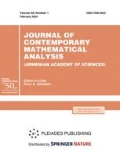Abstract
The paper considers measures in the space \(\mathbb{E}\) of planes in \(\mathbb{R}^{3}\), and combinatorial decompositions for their values on ‘‘Buffon sets’’ in \(\mathbb{E}\). These decompositions, written in terms of a ‘‘wedge function’’ depending on the measure, have been known since long in Combinatorial Integral Geometry, yet their explicit expressions have been well established only for ‘‘non-degenerate’’ Buffon sets. Theorem 1 removes this gap and presents a decomposition algorithm valid with no similar restriction. Theorem 2 presents a result in a direction converse to Theorem 1. Starting from the decomposition algorithm, a combinatorial valuation \(\Psi_{F}\) is defined that depends on ‘‘general’’ continuous additive wedge function \(F(W)\). The question is: when \(\Psi_{F}\) becomes a measure in the space \(\mathbb{E}\)? Theorem 2 points at special ‘‘tetrahedral inequalities’’, the analogues of triangular inequalities of the planar theory. If \(\Psi_{F}\) satisfies these ‘‘tetrahedral inequalities’’, then \(\Psi_{F}\) becomes a measure and the corresponding \(F(W)\) is called a ‘‘wedge metric’’ (to stress the connection of the paper’s topic with Hilbert’s Fourth Problem).

Similar content being viewed by others
REFERENCES
R. Alexander, ‘‘Book review on ‘Combinatorial integral geometry with applications to mathematical stereology,’’ Bull. (New Ser.) Am. Math. Soc. 10, 318–321 (1984).
R. Alexander, ‘‘Planes for which the lines are the shortest paths between points,’’ Ill. J. Math. 22, 177–190 (1978). https://doi.org/10.1215/ijm/1256048729
‘‘The solution of the Buffon–Sylvester problem in R3,’’ Z. Wahrscheinlichkeitstheorie Verw. Geb. 27, 53–74 (1973). https://doi.org/10.1007/BF00736008
R. V. Ambartzumian, ‘‘A note on pseudometrics on the plane,’’ Z. Wahrscheinlichkeitstheorie Verw. Geb. 37, 145–155 (1976). https://doi.org/10.1007/BF00536777
R. V. Ambartzumian, ‘‘Stochastic Geometry from the standpoint of integral geometry,’’ Adv. Appl. Prob. 9, 792–823 (1977).https://doi.org/10.2307/1426701
R. V. Ambartzumian, Combinatorial Integral Geometry with Applications to Mathematical Stereology (Wiley, Somerset, NJ, 1982).
R. V. Ambartzumian, ‘‘Combinatorial integral geometry, metrics and zonoids,’’ Acta Appl. Math. 9, 3–27 (1987). https://doi.org/10.1007/BF00580819
R. V. Ambartzumian, Factorization Calculus and Geomertic Probability (Cambridge Univ. Press, Cambridge, 1990). https://doi.org/10.1017/CBO9781139086561
R. V. Ambartzumian, ‘‘Parallel X-ray tomography of convex domains as a search problem in two dimensions,’’ J. Contemp. Math. Anal. 48, 23–34 (2013). https://doi.org/10.3103/S1068362313010032.
R. V. Ambartzumian, ‘‘Sevan methodologies revisited: random line processes’’, J. Contemp. Math. Anal., 48, 4–22 (2013). https://doi.org/10.3103/S1068362313010020
R. H. Aramyan, ‘‘Measures in the space of planes and convex bodies,’’ J. Contemp. Math. Anal. 47, 78–85 (2012). https://doi.org/10.3103/S1068362312020045
R. H. Aramyan, ‘‘Reconstruction of measures in the space of planes,’’ Lobachevskii J. Math. 32, 241–246 (2011). https://doi.org/10.1134/S1995080211040044
A. Baddeley, ‘‘Combinatorial foundations of stochastic geometry,’’ Proc. London Math. Soc. s3-42, 151–177 (1980). https://doi.org/10.1112/plms/s3-42.1.151
H. Busemann, ‘‘Herbert geometries in which the planes minimize area,’’ Ann. Mat. Pura Appl. 55 (4), 171–189 (1961).https://doi.org/10.1007/BF02412083
G. Yu. Panina, ‘‘Many-dimensional combinatorial Ambartzumian’s formulae’’, Math. Nachr., 159, 271–277 (1992). https://doi.org/10.1002/mana.19921590118
Stochastic Geometry, Ed. by E. F. Harding and D. G. Kendall (Wiley, New York, 1974).
J. C. Álvarez Paiva, ‘‘Hilbert’s fourth problem in two dimensions I,’’ in Mass Selecta: Teaching and Learning Advanced Undergraduate Mathematics, Ed. by S. Katok, A. Sossinsky, and S. Tabachnikov (Amer. Math. Soc., Rhode Island, 2003), pp. 165–183.
L. A. Santalo, Integral Geometry and Geometric Probability (Addison-Wesley, Reading, MA, 1976).
R. Schneider, ‘‘Crofton measures in projective finsler spaces,’’ in Integral Geometry and Convexity, Ed. by E. L. Grinberg, Sh. li, G. Zhang, and J. Zhou (World Scientific, Singapore, 2006). https://doi.org/10.1142/9789812774644_0006
Z. I. Szabó, ‘‘Hilbert’s fourth problem, I,’’ Adv. Math. 59, 185–301 (1986). https://doi.org/10.1016/0001-8708(86)90056-3
Author information
Authors and Affiliations
Corresponding author
About this article
Cite this article
Ambartzumian, R.V. On Continuity of Buffon Functionals in the Space of Planes in \(\boldsymbol{\mathbb{R}}^{\mathbf{3}}\) . J. Contemp. Mathemat. Anal. 55, 335–343 (2020). https://doi.org/10.3103/S1068362320060035
Received:
Revised:
Accepted:
Published:
Issue Date:
DOI: https://doi.org/10.3103/S1068362320060035



